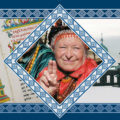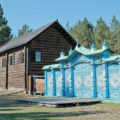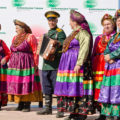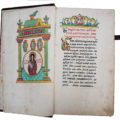- Традиционная изба старообрядцев украшена северной домовой резьбой. Traditional Old Believer house decorated by northern carvings. Фото: Oleg Golovnev © shutterstock.com
- Традиционная изба старообрядцев расписана в бурятской и восточно-славянской живописных традициях| Traditional Old Believer house painted in the Buryat and east-Slavic traditional style. Фото: © starovery.narod.ru
- Фото: Oleg Golovnev © shutterstock.com
- Храм святителя Николая в п. Верхняя Березовка. St. Nicholas Church, Verkhnyaya Berezovka settlement. Фото: 9XY0 © shutterstock.com
- Фото: © arigus.tv
The first Semeiskie groups of the so-called “Old Believers” appeared in the region east of Lake Baikal, or Transbaikal, over 250 years ago. They have lived a secluded life, which allowed them to preserve their authentic music and songs, as well as unique applied arts. This is why the cultural space and oral culture of the Semeiskie are included in the UNESCO List of the Intangible Cultural Heritage of Humanity.
Background
In the second half of the 17th century, Patriarch Nikon performed a revision of church books and rituals to bring them in line with the Greek tradition. However, not all believers adopted the change. The dissenters created a patchy religious movement that was called the Old Believers. They were persecuted for their dissent, and many of them fled to the far-away Russian regions and abroad.
When Catherine II came to power, the issue of colonization of Siberia came to the forefront and a large number of Old Believers moved to Transbaikal from the territories of Belarus and Ukraine that became part of the Russian Empire after the first partition of Poland. The process took place over two decades in several stages, and by the end of the 18th century, there were already 30 settlements with a total population of about 40,000 people. The settlers moved in large families of 15–20 people, so locals called them Semeiskie, from the word “semya”, “family”.
There are currently around 200,000 Semeiskie people in the world, about half of them in Transbaikal. They live in Bichur, Mukhorshibir, Tarbagatai, Zaigraevo, Barguzin, Selenginsk, Kyakhta, Khorinsk and Ulan-Ude. Others have settled in the Chita region and in the Far East, near Amur River, in Yakutia, China (Manchuria), Argentina, Bolivia, Brazil, Uruguay, the USA, Canada, New Zealand, and Australia.
Several centuries have passed, and the strong-minded, hardworking people who are true to the traditions of their ancestors have become real Siberians. The Semeiskie culture took shape gradually. It is based on the traditions of medieval Russia, with main elements taken from the 16–17th century culture of central, southern and northern Russia. It also bears traces of Polish culture and over time has assumed certain features of the Buryat culture. Visiting their villages is like traveling in a time machine.
Dwelling
The Old Believer villages in Transbaikal were quite large. They had several streets in 1-2 rows along rivers and streams. Houses were organized according to the Russian tradition of peasant estates. The front yard included the house itself, sometimes a winter hut, a barn, a cellar, a shed for carts, sleighs and other equipment. The estate had a high fence around it, sometimes coupled with a palisade made of wooden poles.
Large and tall wooden houses were build from very thick logs and had a ridge roof. Windows were located so high that a person could barely reach them, and the gates were impenetrable and tall. The housed of Old Believers could have four, five or six walls. The walls were painted with ochre, carvings decorated the window moldings, and the shutters were painted in bright colors. The decorations included Northern carvings, Ukrainian and Buryat paintings. The main gates were also richly decorated with carvings and paintings, had a gable shed or a roof. Such gates demonstrated the wealth of the family.
The houses are always very neat and clean, with painted ceilings and rugs on the floor. Orthodox icons were located in the so-called God’s corner, and wide wooden benches extended to the left and to the right. The mirror on the wall was enframed with a towel. The table was covered with a homespun tablecloth, with hot polished samovar on it. Furniture in Semeiskie homes was made of wood and was very solid, durable and practical. Furniture pieces were decorated with carvings and were painted with mineral or oil paints.
Garments
The traditional costume of the Old Believers is just as eclectic as their entire culture. It preserves traces of costumes of the north-western, southern and south-western regions of Russia of the 17–18th centuries, seamlessly combining them with elements of Ukrainian, Belarusian and Polish outfits. When the Old Believers moved to Transbaikal, it incorporated another, quite unexpected, component — Chinese fabrics. Other important elements were soft leather and cloth shoes of the Buryat style, furs of domestic and wild animals used in winter garments.
The women’s attire consists of 12 elements: warm clothing (fur coats, robe, and bekesh, the knee-length winter fur coat), outerwear (sundress, skirt, shirt, and an apron), homespun belt (also an element of men’s outfit), hats (caps and kokoshniks), headscarf, and shoes garters.
Jewelry was another important element of the outfit and included pearls, beads, live or artificial flowers, bird feathers, and ribbons. Semeiskie women are especially fond of amber beads. On holidays, they wear 3–8 strings of such beads around their necks.
Men wore the same attire as the rest of the Russian people. The outfit included skewed-collared shirts, pants, homespun belts, coats and overcoats. Men also wore round felt hats or woolen caps.
Kids outfit was the same as the adult one.
Folklore traditions
Of course, the most precious folklore of the Semeiskie in Transbaikal is the one of a kind chant called znamenny, or “hook” chant. It got its name from special musical signs — “znamena” (“hooks”). It is based on the church chant that was common before the schism. Over time, people began to sing secular songs in the same manner. This chant is so complex that it is studied in higher educational musical institutions not only in Russia, but also in Europe and America. Not everyone can immediately hear, understand and appreciate the real beauty of the ancient chant. Polyphony is an important feature of such songs.
Knowledge of the znamenny chant has always been highly esteemed. There were schools for boys where an experienced local singer taught spelling and singing to 10–20 pupils during one year. We can easily calculate that in a decade, one village acquired 100–200 professional church singers. The Semeiskie communities even had singing associations made of family members or neighbors.
The Semeiskie art of spiritual poetry is a very closely related form of folklore. Spiritual poems as well as historical, educational or lyrical ones were performed by the Old Believers with great skill. Poems were memorized by ear. The spiritual verses often quote the Gospel, remind of repentance and of the eternal torment for sins in a moralizing form.
The Semeiskie folklore also features other genres: ritual and calendar-ritual poetry; lyrical songs; non-fairytale prose; ritual charms; keening; riddles; folksay; proverbs; ditties.
Every Old Believer village has folk choirs or ensembles. The most famous are the “Istoki” folk choir of Transbaikal, “Sudbinushka” ethnographic ensemble and “Bylina” folk choir from the village of Tarbagatai, and the Bolshoi Kunalei folk choir.
Marina Skvortsova






